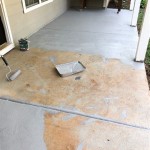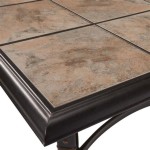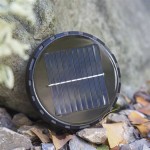How To Get Rid Of Ant Hills On Your Patio
Ant hills on a patio can be a nuisance, detracting from the aesthetic appeal of the space and potentially leading to structural issues if left unaddressed. These unsightly mounds are not only an eyesore but also an indication of an ant colony residing beneath the patio's surface. Effectively eliminating these ant hills requires a comprehensive approach that targets the colony itself, rather than simply removing the surface evidence.
Understanding the behavior and habits of ants is crucial for developing the most effective removal strategy. Ants are social insects, and an ant hill is merely the visible entrance to an extensive underground network of tunnels and chambers. The size of the colony and the specific species of ant will influence the difficulty and methods required for eradication. Different ant species may exhibit different preferences for nesting locations and food sources, requiring tailored removal techniques for optimal success.
Several methods, ranging from natural remedies to chemical solutions, can be employed to eliminate ant hills on a patio. The choice of method will depend on factors such as the severity of the infestation, the tolerance for chemical use, and the desired speed of results. It is essential to consider the potential impact of any chosen method on the surrounding environment, including plants, pets, and other beneficial insects.
Identifying the Ant Species
Before attempting any control measures, identifying the ant species responsible for the patio ant hills is beneficial. Different ant species respond differently to treatment methods. For example, some ants are attracted to sugary baits, while others prefer protein-based baits. Common patio invaders include pavement ants, which are small brown or black ants that nest in cracks in pavement and along sidewalks; odorous house ants, which emit a distinctive odor when crushed; and carpenter ants, which can cause structural damage to wooden elements if present.
Observing the ants' behavior and physical characteristics can provide clues to their identity. Note the size, color, and shape of the ants. Pay attention to their trail patterns and the types of food they are attracted to. Consulting with a local pest control professional or using online resources that provide ant identification guides can also be helpful in accurately identifying the species.
Accurate identification enables the selection of the most effective bait and control method. Using the wrong type of bait will simply attract more ants without eliminating the colony. For instance, if the ants are primarily feeding on grease and protein, a sugar-based bait will be ineffective. Knowing the specific species also allows for targeted treatment of the colony's nesting habits. Carpenter ants, for instance, require different control measures than pavement ants because they nest in wood structures.
Natural and Non-Toxic Ant Removal Methods
For those seeking environmentally friendly and non-toxic solutions, several natural remedies can effectively eliminate ant hills on a patio. These methods often involve using readily available household ingredients and pose minimal risk to people, pets, and the environment. While natural methods may take longer to produce results than chemical solutions, they are a safer and more sustainable option for ant control.
Boiling water is a simple and effective method for destroying ant colonies. Pouring boiling water directly into the ant hill can kill ants on contact and collapse the tunnels within the colony. However, it is essential to exercise caution when using boiling water to avoid burns. This method is most effective when applied repeatedly over several days to ensure that all ants are reached. Boiling water can also damage surrounding vegetation, so it should be used carefully and avoid direct contact with plants.
Diatomaceous earth (DE) is a naturally occurring powder made from the fossilized remains of diatoms, a type of algae. It is non-toxic to humans and pets but deadly to insects. DE works by absorbing the waxy coating on an ant's exoskeleton, causing it to dehydrate and die. Sprinkle DE around the base of the ant hill and along ant trails. Ensure that you use food-grade DE, as other types may contain additives that are harmful. DE is most effective when dry, so it may need to be reapplied after rain or watering.
Vinegar is another common household ingredient that can be used to deter ants. A solution of equal parts vinegar and water can be sprayed directly onto ants and their trails to disrupt their scent markings. Vinegar also has a repellent effect, discouraging ants from returning to the treated area. While vinegar is not as effective at killing ants as boiling water or DE, it can be a useful tool for controlling ant populations on a patio. White vinegar is generally the most effective type for ant control.
Borax, also known as sodium borate, is a naturally occurring mineral that can be mixed with sugar to create an effective ant bait. The sugar attracts the ants, while the borax poisons them when ingested. Mix one teaspoon of borax with one cup of warm water and one-quarter cup of sugar. Soak cotton balls in the solution and place them near the ant hills. The ants will carry the borax-laden sugar back to the colony, eventually killing the entire nest. Borax can be harmful if ingested in large quantities, so it should be kept out of reach of children and pets.
Citrus peels, particularly lemon and orange peels, contain a natural compound called d-limonene, which is toxic to ants. Grind up citrus peels and sprinkle them around the base of the ant hill and along ant trails. The d-limonene will disrupt the ants' nervous system, eventually killing them. Citrus peels also have a pleasant smell and can help to deodorize the patio area.
Chemical Ant Control Options
For more severe ant infestations or when natural methods have proven ineffective, chemical ant control options may be necessary. These options typically involve using insecticides that kill ants on contact or through ingestion. It is crucial to use chemical ant control products responsibly and follow the manufacturer's instructions carefully to minimize potential risks to humans, pets, and the environment.
Ant baits are one of the most effective chemical ant control methods. Ant baits contain an insecticide mixed with a food source that attracts ants. The ants carry the bait back to the colony, where it is shared with other ants, eventually leading to the colony's demise. Ant baits are available in various formulations, including liquid baits, gel baits, and granular baits. The choice of bait will depend on the type of ant species you are dealing with and the location of the ant hills.
Insecticide sprays can be used to kill ants on contact. These sprays typically contain synthetic pyrethroids, which are nerve poisons that disrupt the ants' nervous system. Insecticide sprays can be applied directly to ant hills, ant trails, and other areas where ants are present. However, insecticide sprays can also be harmful to beneficial insects and other wildlife, so they should be used with caution. It is important to choose a spray that is specifically labeled for ant control and follow the manufacturer's instructions carefully.
Insecticide dusts are another option for controlling ants. These dusts are typically made from pyrethroids or other insecticides and are applied directly to ant hills and other areas where ants are present. Insecticide dusts can be effective for controlling ants in hard-to-reach areas, such as cracks and crevices. However, insecticide dusts can also be easily dispersed by wind and rain, so they should be used carefully and protected from the elements.
When using chemical ant control products, it is essential to take precautions to protect yourself and others. Wear gloves and eye protection when handling insecticides. Keep children and pets away from treated areas until the insecticide has dried or settled. Avoid spraying insecticides near food or water sources. If you are unsure about how to use a particular insecticide, consult with a pest control professional.
Professional pest control services offer a comprehensive approach to ant control. These services employ trained technicians who can identify the ant species, assess the extent of the infestation, and develop a customized treatment plan. Professional pest control services typically use industrial-strength insecticides and application techniques that are not available to the general public. While professional services can be more expensive than DIY methods, they can provide a more effective and long-lasting solution to ant problems.

How To Get Rid Of Ants In Your Pavers Pestxpert

How To Get Rid Of Ants On A Brick Patio Js Pavers

How To Get Rid Of Ant Hills On Your Lawn Greensleeves

How To Get Rid Of Pavement Ants 3 Simple Steps

How To Eradicate A Pavement Ant Infestation Gardener S Path
Ants Digging Up Dirt Under Pavers Outdoor Ant Treatment

How Do I Get Rid Of Ant Hills In My Lawn George Davies Turf

How To Eradicate A Pavement Ant Infestation Gardener S Path

How To Get Rid Of Ants Under Paving

What To Do About Pavement Ants That Linger For A Week Yale Pest Control








